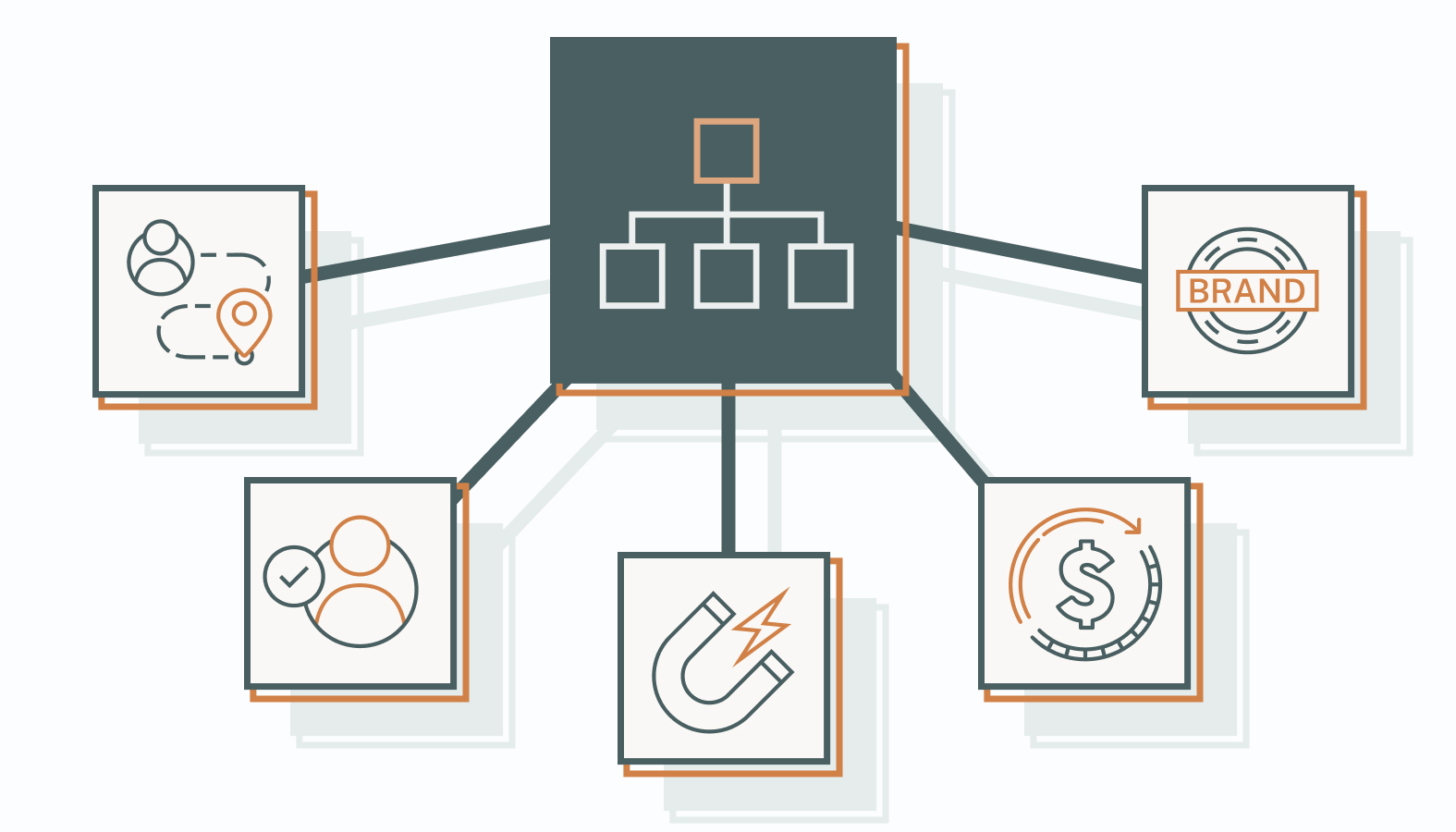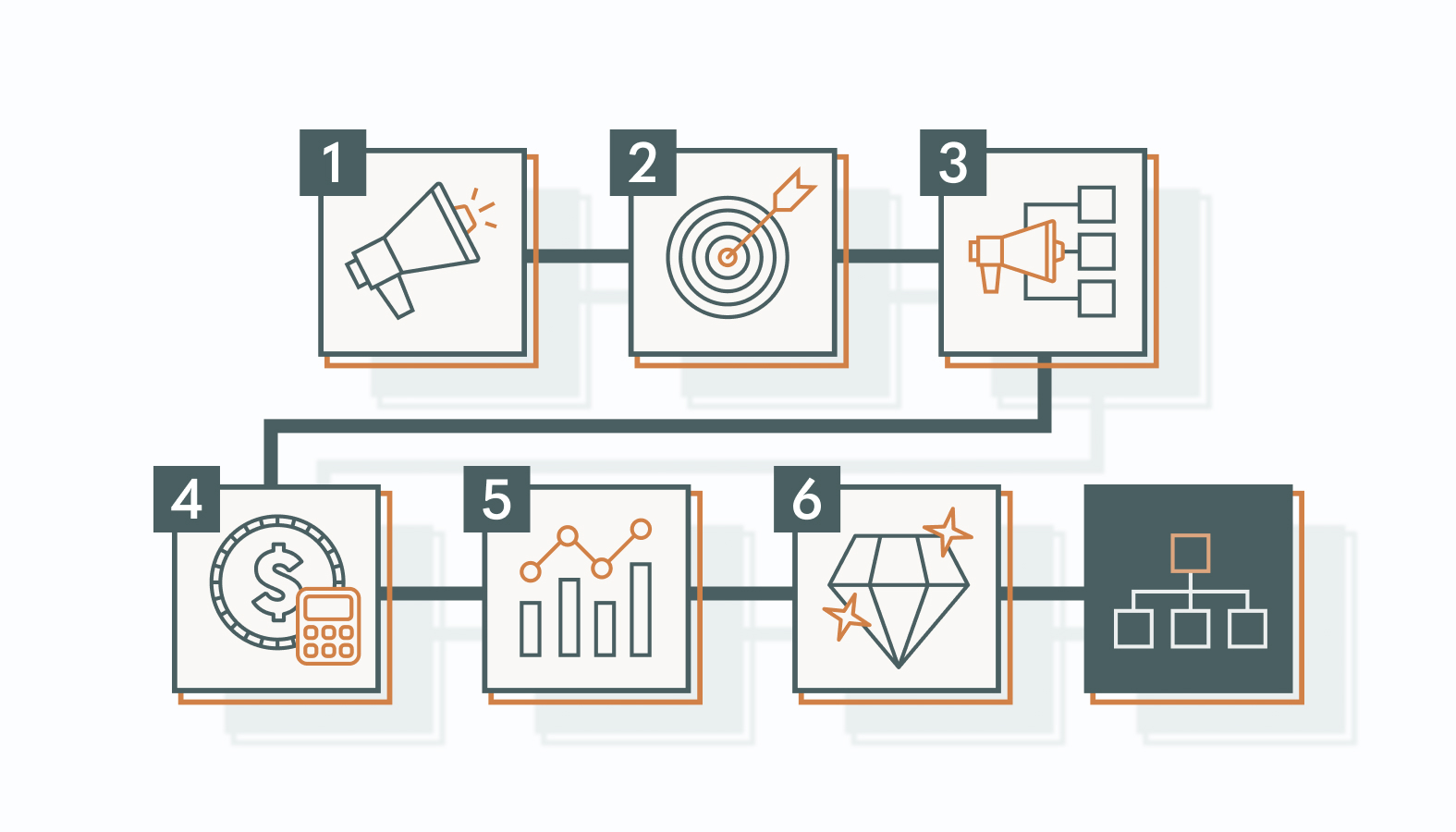Marketing today isn’t just about showing up—it’s about creating a seamless experience that follows your customers wherever they go.
Imagine this: A customer sees your ad on Facebook, clicks through to your website, and later completes their purchase in your app. No hiccups, no repetition—just one smooth, connected journey. That’s the magic of cross-channel marketing.
Unlike multi-channel marketing, which simply places your brand on different platforms, cross-channel marketing links those platforms together. It ensures data flows between them so customers move effortlessly from one touchpoint to the next.
Sound complicated? It doesn’t have to be. In this guide, we’ll break it down and show you how to create a seamless, high-impact strategy that keeps customers engaged—without the guesswork.
Explore Cross-Channel Marketing Strategies
Reaching customers effectively means using multiple marketing channels—but how you connect those channels makes all the difference. Cross-channel marketing ensures a smooth customer experience by linking different platforms, making interactions feel effortless and connected.
Clarify Key Terms and Distinctions
Not all multi-platform marketing works the same way. Here’s how cross-channel, multichannel, and omnichannel marketing compare:
- Cross-Channel Marketing: In this approach, different marketing channels work together, allowing customers to move smoothly from one channel to another. For instance, a customer gets an email with a discount code and then uses it on the brand’s mobile app. This strategy ensures a cohesive customer journey, enhancing engagement and conversion rates.
- Multichannel Marketing: Multiple channels operate separately, meaning customers may get different experiences depending on where they interact. A company might run social media ads, send emails, and offer in-store promotions, but none connect.
- Omnichannel Marketing: This takes cross-channel marketing to the next level. In this approach, every channel is fully connected, providing a consistent experience no matter where or how a customer engages. Think of a retailer where online, mobile and in-store interactions sync perfectly, remembering preferences and past purchases.
Evolution of Marketing Channels
From one-track strategies to fully connected experiences, marketing has come a long way. Here’s how it all unfolded:
- Single-Channel Marketing: Traditionally, businesses used one method—print ads, direct mail, or a single platform. This method worked, even with limited reach and engagement, but customers started expecting more.
- Multichannel Evolution: As new platforms emerged (TV, radio, early digital), businesses expanded their reach and utilized multiple channels with their marketing strategies. The problem? Each channel operated in its own bubble, which led to fragmented customer experiences.
- Cross-Channel Integration: Enter digital innovation. Brands started linking channels together, allowing customers to move between them more smoothly—think an email promo leading to a mobile purchase. Cross-channel marketing enabled a more cohesive customer journey across various touchpoints.
- Omnichannel Emergence: The current gold standard. Every interaction, online or offline, syncs up to create a seamless, personalized experience. Data and tech drive the show, ensuring customers get exactly what they need, when and where they want it.
Marketing isn’t just evolving—it’s leveling up. Understanding these strategies (and their distinctions) is the first step in creating a more thoughtful marketing approach.
Benefits of Cross-Channel Marketing
Modern businesses need more than just good marketing—they need smart marketing. Cross-channel marketing connects different platforms to create a smooth, engaging customer experience. The result? Better engagement, streamlined operations, and stronger business performance.
Here’s how it pays off.
Streamline the Customer Journey
Cross-channel marketing is critical in creating a cohesive and unified customer experience across all touchpoints. When businesses ensure every interaction feels seamless and relevant, customer satisfaction (and loyalty) skyrockets.
Take Starbucks, for example. Their mobile app syncs perfectly with in-store visits—letting customers check rewards, order ahead, and snag promotions without a hitch. This integration has led to happier customers, more repeat visits, and a brand experience that just works.
Unlock Powerful Customer Insights
When you connect data from multiple channels, you get a crystal-clear picture of what your customers want, how they behave, and what makes them tick. That intel helps you make smarter decisions and deliver marketing that actually resonates.
Just look at Amazon—they don’t guess, they know. By analyzing interactions across their website, app, and emails, they spot trends, predict what customers will buy next, and serve up personalized recommendations. The result? More sales, happier customers, and marketing that feels like magic.
Boost Your Reach and Engagement
More channels mean more chances to connect with your audience. The more places your brand shows up, the more customers engage—and that’s how you turn visibility into loyalty.
Smart marketers use tools like HubSpot and Salesforce Marketing Cloud to keep everything running smoothly. These platforms help track, sync, and optimize campaigns across multiple channels, ensuring your strategy stays sharp and your audience stays hooked.
Work Smarter, Increase ROI
Cross-channel marketing gets results without wasting resources. When your campaigns are precisely targeted, you get more bang for your marketing buck, driving higher ROI.
Consider this: A study by the Aberdeen Group found that businesses with strong cross-channel strategies keep 89% of their customers. Those without? Just 33%. That kind of retention translates into significant savings, increased profitability, and improved customer loyalty.
Keep Your Brand Message Strong and Consistent
Staying consistent across all marketing channels builds trust and reinforces your brand identity. No matter where customers interact with you—social media, email, or in-store—they should get the same core message and experience.
To maintain consistency, businesses can develop clear brand guidelines that define tone, style, and messaging. Regular check-ins on your marketing materials help ensure everything stays aligned, even when adapting content for different platforms.
A strong, unified message boosts marketing, deepens customer relationships, and keeps your brand top of mind.
Strategic Planning for Cross-Channel Marketing
A solid game plan is the secret weapon of cross-channel marketing. When businesses sync up their marketing across different platforms, they create a smooth, engaging customer experience while keeping their brand message crystal clear.
A well-planned strategy aligns marketing, business goals, and resources so companies can engage customers more effectively without wasting time or budget. In short, work smarter, not harder.
Here’s how to do it properly:
1) Evaluate Your Current Marketing Setup
Before diving into cross-channel marketing, take a step back and analyze what’s already in place. Which marketing channels are working? Which ones aren’t pulling their weight? Understanding the strengths and weaknesses of your current setup helps you spot areas for improvement and streamline your efforts.
Studying your competitors can also give you an edge.
How are they using different marketing channels?
What’s working for them, and where are they falling short?
A competitive analysis helps you benchmark your strategies, find gaps in your approach, and uncover opportunities to stand out. The goal is to build a smarter, more efficient marketing ecosystem that delivers better results.
2) Set Clear Marketing Objectives
If you don’t know where you’re going, how do you expect to get there? Defining clear, measurable goals keeps your cross-channel marketing on track and aligned with your overall business objectives. Use SMART—specific, measurable, attainable, relevant, and time-bound.
Your goals might include growing brand awareness, driving sales, or keeping customers engaged long-term. For example, aiming for a 20% boost in brand awareness over six months with a multi-channel campaign gives you a clear target.
Well-defined objectives shape your marketing strategy and provide key metrics to measure success. In short, if you can’t track it, you can’t optimize it.
3) Choose the Right Channels and Touchpoints
Not all marketing channels are created equal, and not every customer interacts with your brand the same way. The goal is to meet them where they are. Start by digging into customer data to determine which platforms they use most and how they engage with your brand.
Once you know where your audience hangs out, it’s time to connect the dots. Your channels—whether social media, email, website, or in-store experience—should work together like a well-oiled machine.
For example, a retailer can sync social media ads, email campaigns, and in-store promotions to create a smooth, unified customer journey. The result? A brand experience that feels effortless for customers and drives better engagement for you.
4) Allocate Resources and Budget Wisely
Having an excellent strategy is not enough. To succeed in cross-channel marketing, ensure you have the right resources to execute it. That means smartly distributing your budget, team, and technology to get the best results.
Start by identifying your top-performing channels and investing more in what’s already driving results. At the same time, set aside part of your budget for testing new platforms and emerging trends—because innovation keeps you ahead of the competition.
Think of it like building a winning team: you double down on your star players while scouting fresh talent to keep things dynamic. Balancing proven strategies with calculated experimentation ensures every dollar works harder and every campaign delivers maximum impact.
5) Implement Tracking and Analytics Like a Pro
In any marketing campaign, you can’t improve what you don’t measure. Solid tracking and analytics give you the insights to fine-tune your cross-channel strategy and maximize results.
Start by identifying key performance indicators (KPIs) that align with your goals—things like conversion rates, customer acquisition costs, and lifetime value. These metrics reveal what’s working, what’s not, and where you should pivot.
Leverage tools like Google Analytics, Adobe Analytics, or a customer data platform (CDP) to gather data from every channel. The real magic happens when you analyze this data in real time, adjusting your campaigns on the fly to stay ahead of customer trends.
In short, tracking and analytics aren’t just about numbers—they’re your secret weapon for making smarter, faster, and more profitable marketing moves.
6) Review and Optimize Regularly—Because Standing Still Is Not an Option
Cross-channel marketing isn’t a “set it and forget it” game. You must regularly review and refine your strategy to keep up with shifting market trends, evolving technology, and changing customer behavior.
Start with routine performance audits to pinpoint what’s working and what needs a refresh. Are specific channels underperforming? Is your messaging still resonating? Use actual data—customer feedback, engagement metrics, and conversion rates—to guide your adjustments.
Optimization is about fixing what’s broken and staying ahead. Testing new approaches, tweaking campaigns in real-time, and adopting emerging technologies keep your strategy sharp. The brands that dominate aren’t the ones that play it safe—they’re the ones that adapt, optimize, and evolve.
Best Practices in Cross-Channel Marketing
For maximum impact, your marketing channels should work together seamlessly. Here are the top best practices for effective cross-channel marketing.
Unified Customer View
To deliver truly personalized marketing, you need a complete picture of your customers. By integrating data from all your marketing channels, you can better understand their behaviors, preferences, and needs—allowing you to target them effectively.
To achieve this, businesses should implement a robust Customer Relationship Management (CRM) system. This system collects and centralizes data from every interaction, whether a website visit, an email click, or an in-store purchase.
Pairing a CRM system with data analytics tools helps break down customer segments, uncover trends, and fine-tune campaigns in real-time. The result? Smarter marketing, higher engagement, and stronger customer relationships.
Consistent Branding Across Channels
Your brand should feel the same no matter where customers interact—whether scrolling through social media, opening an email, visiting your website, or walking into your store. Keeping a unified brand image builds trust, strengthens recognition, and creates a seamless customer experience.
To stay consistent, develop clear brand guidelines that cover everything from logo placement and color schemes to tone of voice and messaging. Regularly review marketing materials across all channels to ensure they align with your brand’s identity.
And don’t forget the people behind the marketing—training your team on brand standards ensures that every campaign, ad, and customer interaction stays true to your brand. When everything syncs up, your brand becomes more recognizable, credible, and influential.
Strategically Select Channels
Not every marketing channel is a good fit for every business.
The key is knowing where your audience spends their time and how they prefer to engage with brands.
Choosing the right mix of channels—whether social media, email, search ads, or in-store experiences—ensures your message reaches the right people in the right way.
To make smart decisions, businesses should rely on data, not guesswork. Use analytics to track channel performance and customer engagement. A/B testing different platforms, messaging styles, and formats can reveal what works best.
The goal isn’t just to be everywhere; it’s to be where your efforts make the most impact. Continuously testing and refining your approach can optimize your channel selection and drive better results over time.
Optimize Content for Each Channel
One-size-fits-all content doesn’t cut it. Each marketing channel has its own strengths, limitations, and audience expectations, so your message must be tailored accordingly. Optimizing content for each platform ensures better engagement and a stronger impact.
For example, a long-form blog post packed with insights can be transformed into a snappy Instagram Reel, a compelling LinkedIn article, an eye-catching infographic for email campaigns, or bite-sized Twitter threads. The key is to match the format to the channel while keeping the core message intact.
By repurposing content strategically, businesses can maximize reach and effectiveness without constantly reinventing the wheel.
Seamless Integration and Coordination
For a smooth customer journey, all your marketing channels need to work together like a well-synchronized team. When channels are aligned, customers get a consistent, unified brand experience—no gaps, no confusion, just seamless interaction.
The best way to manage this is to use integrated marketing software that centralizes planning, execution, and analytics. Regular communication between teams—marketing, sales, and customer support—ensures everyone is on the same page and working toward the same goals.
The result? A cohesive, engaging brand experience that feels effortless to the customer (even though behind the scenes, it’s a well-oiled machine).
Common Challenges and How to Overcome Them
Cross-channel marketing has its fair share of challenges, but with the right approach, they’re just roadblocks—not dead ends. Let’s break down common obstacles and how to tackle them head-on.
Disconnected Systems and Integration Issues
A major hurdle in cross-channel marketing is dealing with disconnected systems that create messy data and inconsistent customer experiences. When platforms don’t talk to each other, marketing efforts can feel disjointed and inefficient.
To solve this, invest in technology that connects your channels seamlessly. API-based platforms, middleware solutions, or all-in-one marketing suites can sync data and streamline workflows.
Start by examining your current tech stack. Determine where the gaps are, then choose tools that integrate everything for smoother, more efficient operation.
Drowning in Data: Problems with Data Complexity
With data pouring in from multiple channels, keeping it organized and accurate can be overwhelming.
But high-quality data is the rocket fuel of marketing—without it, your strategy is just a fancy go-kart running on fumes. Keep it clean, keep it organized, or prepare for a bumpy ride.
Start by setting clear data governance policies to ensure consistency across all platforms. Use automation and data-cleaning tools to filter out errors, duplicates, and outdated information.
A centralized data storage system, like a CRM or data warehouse, helps keep everything accessible and aligned.
Also, regular audits will keep your data sharp, reliable, and ready to fuel smarter marketing decisions.
One-Size-Fits-All Marketing for Different Channels
Every marketing channel has its own rules, audience behaviors, and best practices—so treating them all the same is like trying to win a Formula 1 race with a skateboard. It’s just not going to work.
Start by analyzing each platform individually—who’s there, how they engage, and what type of content resonates. Then, look at performance metrics like engagement rates, conversions, and audience demographics to see what’s driving results.
Once you have those insights, fine-tune your messaging, visuals, and delivery methods to fit each channel’s unique strengths. A social media post that grabs attention in seconds won’t perform the same as a long-form email that nurtures leads. Optimizing for each platform ensures your content isn’t just seen—it actually makes an impact.
Disconnected Teams, Disjointed Strategy
If marketing, sales, and customer service aren’t on the same page, your cross-channel strategy is basically a game of telephone—messages get distorted, efforts get duplicated, and customers get confused. Lack of alignment can lead to mixed messaging, missed opportunities, and an overall disjointed brand experience.
Fix this by making collaboration a priority, not an afterthought. Schedule regular cross-team meetings to align goals, share insights, and ensure everyone is rowing in the same direction. Workshops and training sessions can reinforce a unified strategy.
Leverage project management tools like Asana, Trello, or Monday.com to keep teams connected, tasks visible, and communication streamlined. A well-aligned team doesn’t just make marketing smoother—it makes it far more effective.
Struggling to Keep up with Market Shifts
Staying ahead in marketing means keeping a pulse on shifting trends and evolving consumer behavior. If you’re not monitoring and adapting, you’re already falling behind.
Set up systems that track real-time market data and customer feedback to stay agile. Social listening tools, competitive analysis, and analytics dashboards can help spot trends before they go mainstream.
More importantly, build a framework for quick decision-making—because the faster you adjust, the more opportunities you seize (and the fewer pitfalls you hit). Adaptability isn’t just an advantage; it’s survival.
Budget Roadblocks Holding Your Marketing Back
Tight budgets can make cross-channel marketing feel like a high-stakes balancing act. When resources are limited, every dollar needs to work harder.
Start by prioritizing high-ROI channels—double down on what’s delivering results and trim the rest. Use analytics to pinpoint your most effective campaigns and shift funds accordingly. Leverage cost-effective tactics like user-generated content, organic social media engagement, and email marketing to maximize reach without maxing out your budget.
Smart spending isn’t about cutting corners but making every move count. With the right strategy, even a lean budget can fuel powerful marketing campaigns.
Bring It All Together: Cross-Channel Marketing Done Right
Marketing today isn’t just about being present on multiple platforms—it’s about making them work together seamlessly. A scattered approach leaves gaps, confuses customers, and wastes resources. But when your channels are in sync? That’s when the magic happens.
Here’s what you need to do:
- Create a Smooth Customer Journey – Make every interaction feel connected, no matter where it happens.
- Use Data Wisely – Integrated insights mean smarter decisions and marketing that actually works.
- Maximize Your Resources – A well-planned strategy ensures every dollar (and every effort) pulls its weight.
- Stay Consistent – A strong, recognizable brand builds trust and keeps customers coming back.
- Solve Problems Before They Happen – Tackling integration and data challenges upfront leads to smoother execution.
Cross-channel marketing isn’t a trend—it’s the standard. If you’re not doing it (or doing it well), you’re leaving money on the table. Now’s the time to audit your strategy, refine your approach, and build a system that connects the dots. The brands that get this right don’t just attract customers—they keep them.
Taking the Next Step in Your Cross-Channel Marketing Journey
Refining your cross-channel marketing strategy is a game-changer—it helps you reach more people, keep customers engaged, and create a brand experience that just works. With the insights from this guide, you’re ready to tackle modern marketing like a pro.
But no two businesses are the same, and the right strategy makes all the difference. If you’re wondering how to make these ideas work for your goals, we’ve got you covered.
Let’s talk—no sales pitch, no fluff. Just a real conversation about your challenges, opportunities, and how to make cross-channel marketing work for you. Book a quick chat with our experts, and let’s turn strategy into success.











